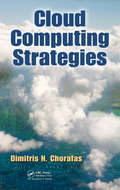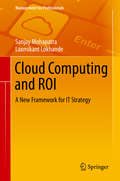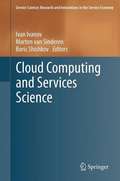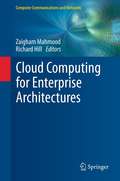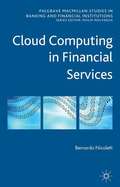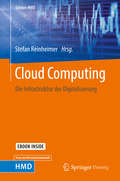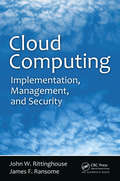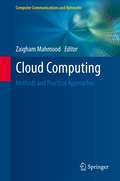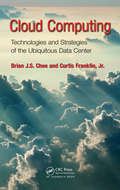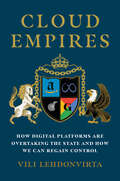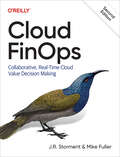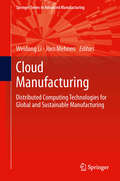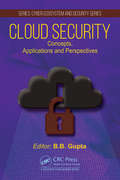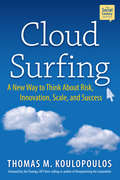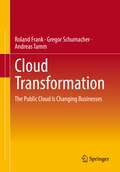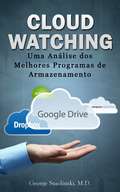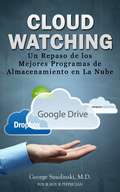- Table View
- List View
Cloud Computing Strategies
by Dimitris N. ChorafasA guide to managing cloud projects, Cloud Computing Strategies provides the understanding required to evaluate the technology and determine how it can be best applied to improve business and enhance your overall corporate strategy. Based on extensive research, it examines the opportunities and challenges that loom in the cloud. It explain
Cloud Computing and ROI: A New Framework for IT Strategy (Management for Professionals)
by Sanjay Mohapatra Laxmikant LokhandeThis book develops an IT strategy for cloud computing that helps businesses evaluate their readiness for cloud services and calculate the ROI. The framework provided helps reduce risks involved in transitioning from traditional "on site" IT strategy to virtual "cloud computing. " Since the advent of cloud computing, many organizations have made substantial gains implementing this innovation. Cloud computing allows companies to focus more on their core competencies, as IT enablement is taken care of through cloud services. Cloud Computing and ROI includes case studies covering retail, automobile and food processing industries. Each of these case studies have successfully implemented the cloud computing framework and their strategies are explained. As cloud computing may not be ideal for all businesses, criteria are also offered to help determine if this strategy should be adopted.
Cloud Computing and Services Science: Second International Conference, Closer 2012, Porto, Portugal, April 18-21, 2012. Revised Selected Papers (Service Science: Research and Innovations in the Service Economy #367)
by Boris Shishkov Marten Van Sinderen Ivan IvanovThe Cloud Computing and Services Science book comprises a collection of the best papers presented at the International Conference on Cloud Computing and Services Science (CLOSER), which was held in The Netherlands in May 2011. In netting papers from the conference researchers and experts from all over the world explore a wide-ranging variety of the emerging Cloud Computing platforms, models, applications and enabling technologies. Further, in several papers the authors exemplify essential links to Services Science as service development abstraction, service innovation, and service engineering, acknowledging the service-orientation in most current IT-driven structures in the Cloud. The Cloud Computing and Services Science book is organized around important dimensions of technology trends in the domain of cloud computing in relation to a broad scientific understanding of modern services emerging from services science. The papers of this book are inspired by scholarly and practical work on the latest advances related to cloud infrastructure, operations, security, services, and management through the global network. This book includes several features that will be helpful, interesting, and inspirational to students, researchers as well as practitioners. Professionals and decision makers working in this field will also benefit from this book
Cloud Computing and Services Science: Third International Conference, CLOSER 2013, Aachen, Germany, May 8-10, 2013, Revised Selected Papers (Communications in Computer and Information Science #453)
by Markus Helfert, Frédéric Desprez, Donald Ferguson and Frank LeymannThis book constitutes the thoroughly refereed proceedings of the Third International Conference on Cloud Computing and Services Science, CLOSER 2013, held in Aachen, Germany, in May 2013. The 8 papers presented were selected from 142 paper submissions. The papers cover the following topics: cloud computing fundamentals; services science foundations for cloud computing; cloud computing platforms and applications; and cloud computing enabling technologies.
Cloud Computing and Services Sciences: International Conference in Cloud Computing and Services Sciences, CLOSER 2014 Barcelona Spain, April 3–5, 2014 Revised Selected Papers (Communications in Computer and Information Science #512)
by Markus Helfert Frédéric Desprez Donald Ferguson Frank Leymann Víctor Méndez MuñozThis book constitutes the thoroughly refereed proceedings of the 4th International Conference on Cloud Computing and Services Science, CLOSER 2014, held in Barcelona, Spain, in April 2014. The 14 papers presented were selected from 127 paper submissions. The papers focus on the following topics: cloud computing fundamentals; services science foundations for cloud computing; cloud computing platforms and applications; cloud computing enabling technologies; and mobile cloud computing services.
Cloud Computing for Enterprise Architectures (Computer Communications and Networks)
by Zaigham Mahmood Richard HillThis important text provides a single point of reference for state-of-the-art cloud computing design and implementation techniques. The book examines cloud computing from the perspective of enterprise architecture, asking the question; how do we realize new business potential with our existing enterprises? Topics and features: with a Foreword by Thomas Erl; contains contributions from an international selection of preeminent experts; presents the state-of-the-art in enterprise architecture approaches with respect to cloud computing models, frameworks, technologies, and applications; discusses potential research directions, and technologies to facilitate the realization of emerging business models through enterprise architecture approaches; provides relevant theoretical frameworks, and the latest empirical research findings.
Cloud Computing for Lawyers
by Nicole Black Richard SusskindAs more businesses move their IT systems into the cloud, lawyers need to ask if cloud computing is right for their firm. Cloud Computing for Lawyers features a discussion of cloud computing fundamentals, an overview of legal cloud computing products, and step-by-step instructions for implementing cloud computing in your practice--including practical tips for securing your data.
Cloud Computing for Logistics (Lecture Notes in Logistics)
by Michael Hompel Jakob Rehof Oliver WolfThis edited monograph brings together research papers covering the state of the art in cloud computing for logistics. The book includes general business object models for intralogistics as well as user-friendly methods for logistics business process design. It also presents a general template for logistics applications from the cloud. The target audience primarily comprises researchers and experts in the field, but the book will also be beneficial for graduate students.
Cloud Computing in Financial Services
by Bernardo NicolettiFinancial institutions must become more innovative in the conduct of their business. Cloud computing helps to achieve several objectives: innovative services, re-engineered processes, business agility and value optimization. Research, consultancy practice and case studies in this book consider the opportunities and risks with vendor relationships.
Cloud Computing, Smart Grid and Innovative Frontiers in Telecommunications: 9th EAI International Conference, CloudComp 2019, and 4th EAI International Conference, SmartGIFT 2019, Beijing, China, December 4-5, 2019, and December 21-22, 2019 (Lecture Notes of the Institute for Computer Sciences, Social Informatics and Telecommunications Engineering #322)
by Wei Xiang Guanfeng Liu Meikang Qiu Tao Huang Xuyun ZhangThis book constitutes the refereed proceedings of the 9thInternational Conference on Cloud Computing, CloudComp 2019, and the 4th International Conference on Smart Grid and Innovative Frontiers in Telecommunications, SmartGIFT 2019, both held in Beijing, China, in December 2019. The55 full papers of both conferences were selected from 113 submissions. CloudComp 2019 presents recent advances and experiences in clouds, cloud computing and related ecosystems and business support. The papers are grouped thematically in tracks on cloud architecture and scheduling; cloud-based data analytics; cloud applications; and cloud security and privacy. SmartGIFT 2019 focus on all aspects of smart grids and telecommunications, broadly understood as the renewable generation and distributed energy resources integration, computational intelligence applications, information and communication technologies.
Cloud Computing: Die Infrastruktur Der Digitalisierung (Edition HMD)
by Stefan ReinheimerDas Herausgeberwerk zeigt Chancen und Risiken des Cloud Computings auf, bringt Lesern das Thema durch anschauliche Beispiele aus Forschung und Praxis näher und zeigt die Implikationen auf, die aus dieser neuen Infrastruktur resultieren. Die Beitragsautoren präsentieren technische Lösungen, Geschäftsmodelle und Visionen, die einerseits die Herausforderungen und Hürden des Cloud Computing aufgreifen – technisch, rechtlich, prozessbezogen – und andererseits die Chancen und Nutzen dieses Architekturansatzes in den Mittelpunkt stellen. Es ist zeitgemäß, IT-Infrastrukturen, Daten und Applikationen aus der lokalen Umgebung in eine Cloud auszulagern. Der Anwender kann sich der angebotenen IT-Dienstleistungen unter Nutzung von Self-Service-Ansätzen bedienen, in Abhängigkeit davon, was und wieviel er gerade benötigt – und auch nur dafür wird gezahlt. Bereitgestellt, gewartet und aktualisiert werden die IT-Ressourcen zentral. Je nach Art der IT-Dienstleistung, die über die Cloud bereitgestellt werden, unterscheidet man zwischen IaaS – Infrastructure as a Service, PaaS – Platform as a Service und SaaS – Software as a Service. Der Sicherheitsbedarf und die Leistungsfähigkeit der Unternehmens-IT entscheiden darüber, ob man diesen Zentralisierungsansatz unternehmensintern in einer Private Cloud oder unternehmensextern in einer Public Cloud umsetzt. Sogenannte Hybrid Clouds sind ein Mittelweg, der sich immer stärker etabliert. Das Buch richtet sich an alle, die sich umfassend und praxisnah zum Thema Cloud Computing informieren möchten und die nach einer modernen Infrastruktur für die Umsetzung von Digitalisierungsansätzen suchen.
Cloud Computing: Implementation, Management, and Security
by John W. Rittinghouse James F. RansomeCloud Computing: Implementation, Management, and Security provides an understanding of what cloud computing really means, explores how disruptive it may become in the future, and examines its advantages and disadvantages. It gives business executives the knowledge necessary to make informed, educated decisions regarding cloud initiatives.The authors first discuss the evolution of computing from a historical perspective, focusing primarily on advances that led to the development of cloud computing. They then survey some of the critical components that are necessary to make the cloud computing paradigm feasible. They also present various standards based on the use and implementation issues surrounding cloud computing and describe the infrastructure management that is maintained by cloud computing service providers. After addressing significant legal and philosophical issues, the book concludes with a hard look at successful cloud computing vendors.Helping to overcome the lack of understanding currently preventing even faster adoption of cloud computing, this book arms readers with guidance essential to make smart, strategic decisions on cloud initiatives.
Cloud Computing: Methods and Practical Approaches (Computer Communications and Networks)
by Zaigham MahmoodThis book presents both state-of-the-art research developments and practical guidance on approaches, technologies and frameworks for the emerging cloud paradigm. Topics and features: presents the state of the art in cloud technologies, infrastructures, and service delivery and deployment models; discusses relevant theoretical frameworks, practical approaches and suggested methodologies; offers guidance and best practices for the development of cloud-based services and infrastructures, and examines management aspects of cloud computing; reviews consumer perspectives on mobile cloud computing and cloud-based enterprise resource planning; explores software performance testing, open-source cloudware support, and assessment methodologies for modernization, migration and pre-migration; describes emerging new methodologies relevant to the cloud paradigm, and provides suggestions for future developments and research directions.
Cloud Computing: Technologies and Strategies of the Ubiquitous Data Center
by Curtis Franklin Jr. Brian J.S. CheeModern computing is no longer about devices but is all about providing services, a natural progression that both consumers and enterprises are eager to embrace. As it can deliver those services, efficiently and with quality, at compelling price levels, cloud computing is with us to stay. Ubiquitously and quite definitively, cloud computing is
Cloud Empires: How Digital Platforms Are Overtaking the State and How We Can Regain Control
by Vili LehdonvirtaThe rise of the platform economy into statelike dominance over the lives of entrepreneurs, users, and workers.The early Internet was a lawless place, populated by scam artists who made buying or selling anything online risky business. Then Amazon, eBay, Upwork, and Apple established secure digital platforms for selling physical goods, crowdsourcing labor, and downloading apps. These tech giants have gone on to rule the Internet like autocrats. How did this happen? How did users and workers become the hapless subjects of online economic empires? The Internet was supposed to liberate us from powerful institutions. In Cloud Empires, digital economy expert Vili Lehdonvirta explores the rise of the platform economy into statelike dominance over our lives and proposes a new way forward. Digital platforms create new marketplaces and prosperity on the Internet, Lehdonvirta explains, but they are ruled by Silicon Valley despots with little or no accountability. Neither workers nor users can &“vote with their feet&” and find another platform because in most cases there isn&’t one. And yet using antitrust law and decentralization to rein in the big tech companies has proven difficult. Lehdonvirta tells the stories of pioneers who helped create—or resist—the new social order established by digital platform companies. The protagonists include the usual suspects—Amazon founder Jeff Bezos, Travis Kalanick of Uber, and Bitcoin&’s inventor Satoshi Nakamoto—as well as Kristy Milland, labor organizer of Amazon&’s Mechanical Turk, and GoFundMe, a crowdfunding platform that has emerged as an ersatz stand-in for the welfare state. Only if we understand digital platforms for what they are—institutions as powerful as the state—can we begin the work of democratizing them.
Cloud FinOps: Collaborative, Real-Time Cloud Value Decision Making
by Mike Fuller J. R. StormentFinOps brings financial accountability to the variable spend model of cloud. Used by the majority of global enterprises, this management practice has grown from a fringe activity to the de facto discipline managing cloud spend. In this book, authors J.R. Storment and Mike Fuller outline the process of building a culture of cloud FinOps by drawing on real-world successes and failures of large-scale cloud spenders.Engineering and finance teams, executives, and FinOps practitioners alike will learn how to build an efficient and effective FinOps machine for data-driven cloud value decision-making. Complete with a road map to get you started, this revised second edition includes new chapters that cover forecasting, sustainability, and connectivity to other frameworks.You'll learn:The DNA of a highly functional cloud FinOps cultureA road map to build executive support for FinOps adoptionHow to understand and forecast your cloud spendingHow to empower engineering and finance to work togetherCost allocation strategies to create accountability for cloud and container spendStrategies for rate discounts from cloud commitmentsWhen and how to implement automation of repetitive cost tasksHow to empower engineering team action on cost efficiency
Cloud Manufacturing: Distributed Computing Technologies for Global and Sustainable Manufacturing (Springer Series in Advanced Manufacturing)
by Weidong Li Jörn MehnenGlobal networks, which are the primary pillars of the modern manufacturing industry and supply chains, can only cope with the new challenges, requirements and demands when supported by new computing and Internet-based technologies. Cloud Manufacturing: Distributed Computing Technologies for Global and Sustainable Manufacturing introduces a new paradigm for scalable service-oriented sustainable and globally distributed manufacturing systems. The eleven chapters in this book provide an updated overview of the latest technological development and applications in relevant research areas. Following an introduction to the essential features of Cloud Computing, chapters cover a range of methods and applications such as the factors that actually affect adoption of the Cloud Computing technology in manufacturing companies and new geometrical simplification method to stream 3-Dimensional design and manufacturing data via the Internet. This is further supported case studies and real life data for Waste Electrical and Electronic Equipment (WEEE) remanufacturing. This compilation of up to date research and literature can be used as a textbook or reference for mechanical, manufacturing, and computer engineering graduate students and researchers for efficient utilization, deployment and development of distributed and Cloud manufacturing systems, services and applications.
Cloud Native Automation with Google Cloud Build: Easily automate tasks in a fully managed, scalable, and secure platform
by Anthony Bushong Kent HuaWritten by two Google Cloud experts, this book will help you to create a concrete foundation of Cloud Build so that you can define workflows and pipelines as builds in Google Cloud BuildKey FeaturesLearn Cloud Build's API and build configuration/schemaApply scalability and security best practices for using Cloud BuildIntegrate Cloud Build with external systems critical to workflowsBook DescriptionWhen adopting cloud infrastructure, you are often looking to modernize the automation of workflows such as continuous integration and software delivery. Minimizing operational overhead via fully managed solutions such as Cloud Build can be tough. Moreover, learning Cloud Build's API and build schema, scalability, security, and integrating Cloud Build with other external systems can be challenging. This book helps you to overcome these challenges by cementing a Google Cloud Build foundation.The book starts with an introduction to Google Cloud Build and explains how it brings value via automation. You will then configure the architecture and environment in which builds run while learning how to execute these builds. Next, you will focus on writing and configuring fully featured builds and executing them securely. You will also review Cloud Build's functionality with practical applications and set up a secure delivery pipeline for GKE. Moving ahead, you will learn how to manage safe roll outs of cloud infrastructure with Terraform. Later, you will build a workflow from local source to production in Cloud Run. Finally, you will integrate Cloud Build with external systems while leveraging Cloud Deploy to manage roll outs.By the end of this book, you'll be able to automate workflows securely by leveraging the principles of Google Cloud Build.What you will learnGet started with Cloud Build the right wayDefine new workflows using the Cloud Build schemaImplement a secure build and deployment environment for GKEAutomate serverless workflows for Cloud Run and Cloud FunctionsIntegrate Cloud Build with source code management and artifact storesDevelop a Cloud Build strategy for your organizationWho this book is forThis book is for cloud engineers and DevOps engineers who manage cloud environments and desire to automate workflows in a fully managed, scalable, and secure platform. You are expected to have an understanding of cloud fundamentals, software delivery, and containerization fundamentals to get the most out of this book.
Cloud Security and Governance
by Sumner Blount Rob ZanellaThe rise of Cloud Computing, with services delivered in the cloudA", offers businesses incredible power and flexibility. It promises the efficient use of human and financial capital resources, reducing infrastructure and operation costs. It proposes a model of computing that is effective at meeting the demands of business in a rapidly changing environment. Security and Compliance Issues One of the most difficult challenges related to Cloud Computing, revolves around the security and compliance issues associated with it. This is a major concern and will continue to be so, with the ever increasing onslaught of regulations impacting security controls. This pocket guide explains and highlights some of the key security and compliance issues surrounding Cloud adoption, and provides helpful insight into how they can be addressed. Read this pocket guide and - Learn what Cloud Computing is - This guide provides a definition of Cloud Computing, before proceeding through essential characteristics that comprise it. Cloud deployment methods and the benefits of Cloud Computing are then discussed. Understand Cloud security and privacy issues - Security and compliance are two of the primary inhibitors in Cloud adoption. This pocket guide highlights the security and privacy considerations to keep in mind when planning your Cloud strategy. Be aware of the key compliance challenges - Cloud compliance has several important challenges that do not relate specifically to security. This guide details some of the key compliance challenges that you will need to address, including multinational considerations, business continuity and disaster recovery, legal issues and specific regulatory requirements. The areas of security and compliance often represent the biggest inhibitors to adoption of Cloud Computing, and because the potential impacts of problems in these areas are so profound, it is essential that you carefully identify your requirements in these areas, perform extensive due diligence, and work with your provider to develop and monitor processes that will help you both succeed. Ensure Successful Cloud Deployment - Buy this essential guide to Cloud Security and Compliance today!
Cloud Security: Concepts, Applications and Perspectives (Cyber Ecosystem and Security)
by Brij B GuptaCloud computing is an indispensable part of the modern Information and Communication Technology (ICT) systems. Cloud computing services have proven to be of significant importance, and promote quickly deployable and scalable IT solutions with reduced infrastructure costs. However, utilization of cloud also raises concerns such as security, privacy, latency, and governance, that keep it from turning into the predominant option for critical frameworks. As such, there is an urgent need to identify these concerns and to address them.Cloud Security: Concepts, Applications and Perspectives is a comprehensive work with substantial technical details for introducing the state-of-the-art research and development on various approaches for security and privacy of cloud services; novel attacks on cloud services; cloud forensics; novel defenses for cloud service attacks; and cloud security analysis. It discusses the present techniques and methodologies, and provides a wide range of examples and illustrations to effectively show the concepts, applications, and perspectives of security in cloud computing. This highly informative book will prepare readers to exercise better protection by understanding the motivation of attackers and to deal with them to mitigate the situation. In addition, it covers future research directions in the domain. This book is suitable for professionals in the field, researchers, students who are want to carry out research in the field of computer and cloud security, faculty members across universities, and software developers engaged in software development in the field.
Cloud Surfing: A New Way to Think About Risk, Innovation, Scale and Success
by Thomas M. KoulopoulosWhen people hear "the Cloud," they think of cloud computing and salesforce.com, just a sliver of what the Cloud is today. The Cloud has grown: it represents the consummate disruptor to structure; a pervasive social and economic network that will soon connect and define more of the world than any other political, social, or economic organization. The Cloud is the first megatrend of the twenty-first century, one that will shape the way we will address virtually every challenge we face for at least the next 100 years. It is where we will all live, work, and play in the coming decades. The Cloud is where your kids go to dive into online play. It's where you meet and make friends in social networks. It's where companies find the next big idea. It's where political campaigns are won and lost. Cloud Surfing is the groundbreaking book that will explain how to access the full value of the Cloud and how to embrace its possibilities.
Cloud Systems in Supply Chains
by Alan Brown Mark Thompson Jerry FishendenCloud Systems in Supply Chains explores the risks that could face supply chain firms if their implementation of cloud systems is not carefully managed or if not appropriately selected and supported. This volume aids supply chain firms in ensuring that their cloud system activities are positioned to assist and sustain their competitive advantages.
Cloud Transformation: The Public Cloud Is Changing Businesses
by Roland Frank Gregor Schumacher Andreas TammIn this book you will learn how the public cloud is significantly changing the cost structures of digital business models and thus existing markets. The relationships between the cloud architectures used, the organization of the company and the price and business models that are possible as a result are shown clearly and so that they can be used in your own company. The authors explain how, one after the other, more and more markets are becoming digital markets and what role marginal costs play in this. They describe how cloud-based IT is disrupting classic IT. This enables small teams to build scalable business models worldwide at zero marginal costs with little investment. The economic effects are clearly illustrated using specific examples. In addition, technical laypeople get an overview of which factors are particularly important for the competitiveness of their digital business models and how managers can influence them. Finally, the book gives practitioners specific guidelines on how the cloud transformation can be carried out in their company. The book is aimed primarily at executives and employees in the specialist departments and IT who want to drive the cloud transformation in their companies. This book is a translation of the original German 1st edition, Cloud-Transformation by Roland Frank, Gregor Schumacher and Andreas Tamm published by Springer Fachmedien Wiesbaden GmbH, part of Springer Nature in 2019. The translation was done with the help of artificial intelligence (machine translation by the service DeepL.com). A subsequent human revision was done primarily in terms of content.
Cloud Watching
by Hugo Martins George SmolinskiOrganizar e armazenar informações sempre foi uma precupação da humanidade desde os tempos antigos e continuará sendo, pois é inerente a natureza humana. Com o advento do Armazenamento Virtual, a forma como lidamos em manter tais informações seguras e organizadas mudou incrivelmente, tornando-se fundamental adaptar-se a esta nova era da tecnologia. E para entender e usar esta tecnologia é que, com grande satisfação, tive o prazer de colaborar na publicação, em português, do livro do Dr. George Smolinski. Sua simplicidade, e a sua efetividade, em elucidar as características e utilização dos principais serviços disponíveis atualmente, faz desta obra ter uma importância singular no meio de tantos outros materias disponíveis.
Cloud Watching: Un Repaso de los Mejores Programas de Almacenamiento en La Nube
by Moisés Moreno Costilla George SmolinskiEn la última decada, la revolución tecnológica ha permitido de manera drástica mejorar la velocidad y eficacia con la que manejamos los negocios. Una notable mejoría se presenta en el almacenamiento en la nube, el cual nos permite almacenar fotos, videos, documentos y más ne la nuve. Ya no necesitamos guardar los archivos en nuestra computadora ni llenar gabinetes de archivos y papeles. Sólo necesitamos ponerlos en la nube y dar clic. Junto con la nueva tecnología, siempre hay preguntas sobre cuál programa es mejor, la mejor funcionalidad y el más seguro. Este libro aborda esas preguntas sobre los mejores programas de almacenamiento disponibles: 1. Google Drive 2. Evernote 3. Dropbox 4. Amazon Cloud Drive 5. Microsoft OneDrive En este libro encontrarás información relacionada a programas así como consejos de cómo maximizar el uso de Google Drive y también encontrarás detalles de programas como Evernote y Evernote Essentialsy cómo maximizar la plataforma. Al final de los repasos individuales, una comparación punto por punto de estos programas de almacenamiento en la nube y una recomendación final.
